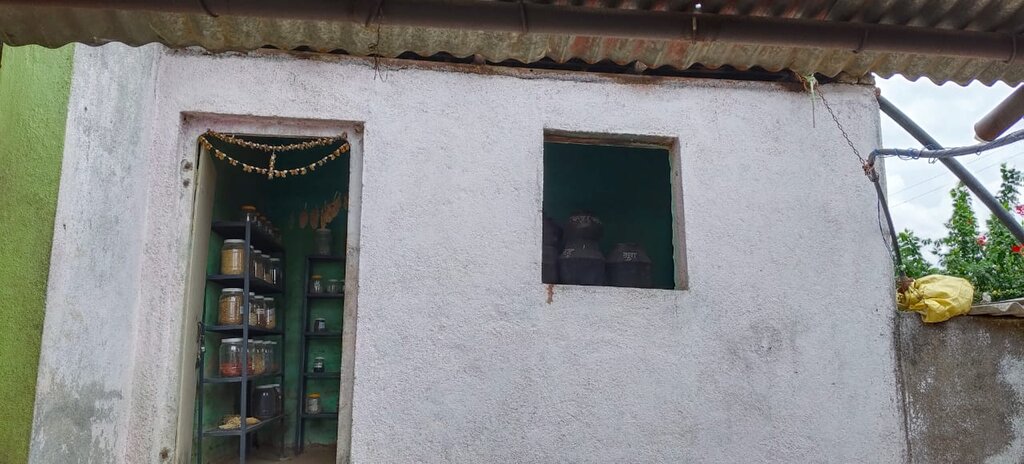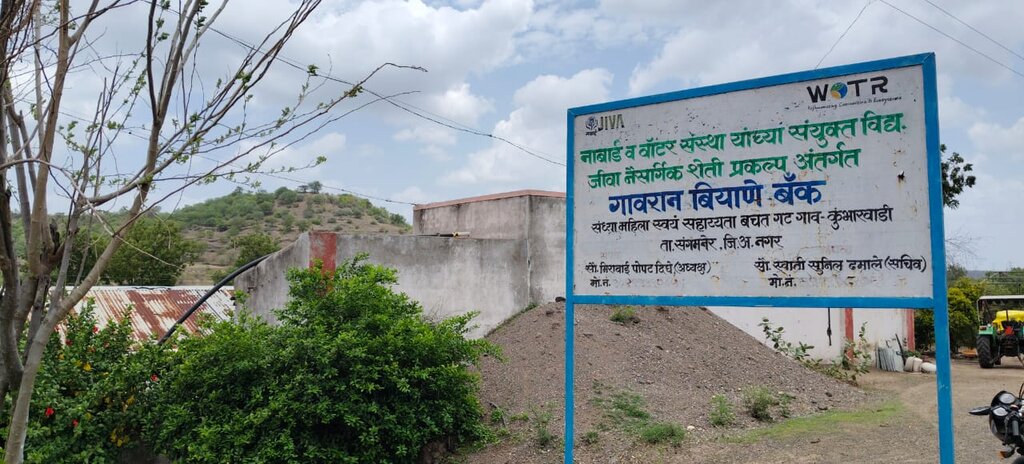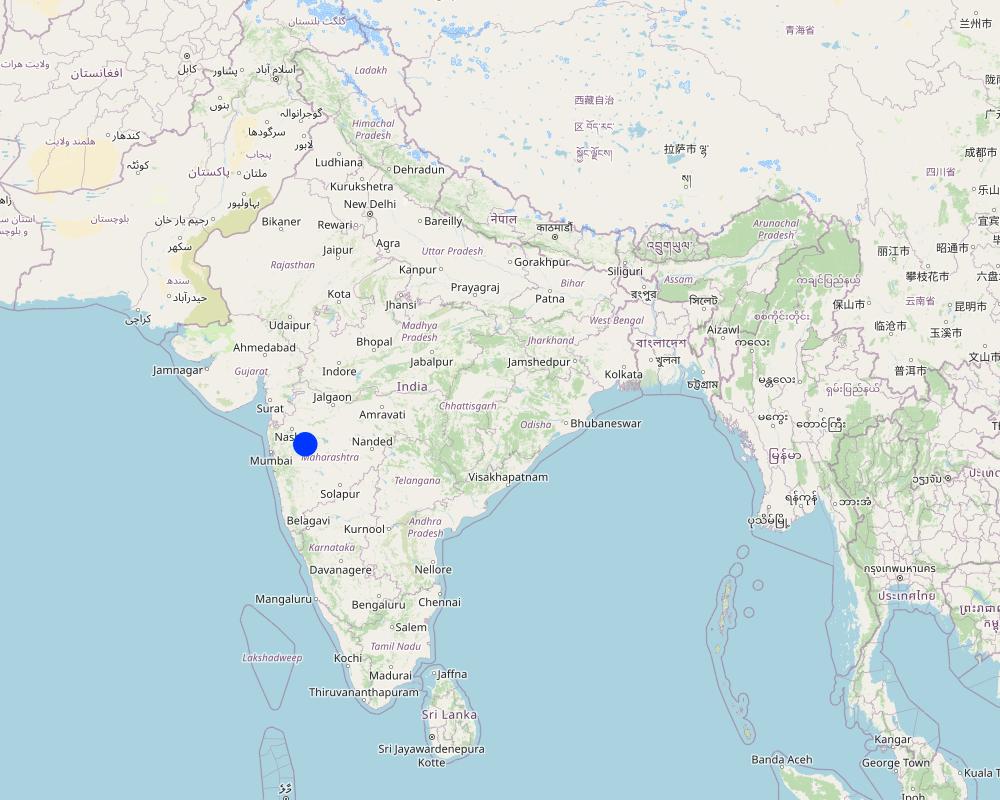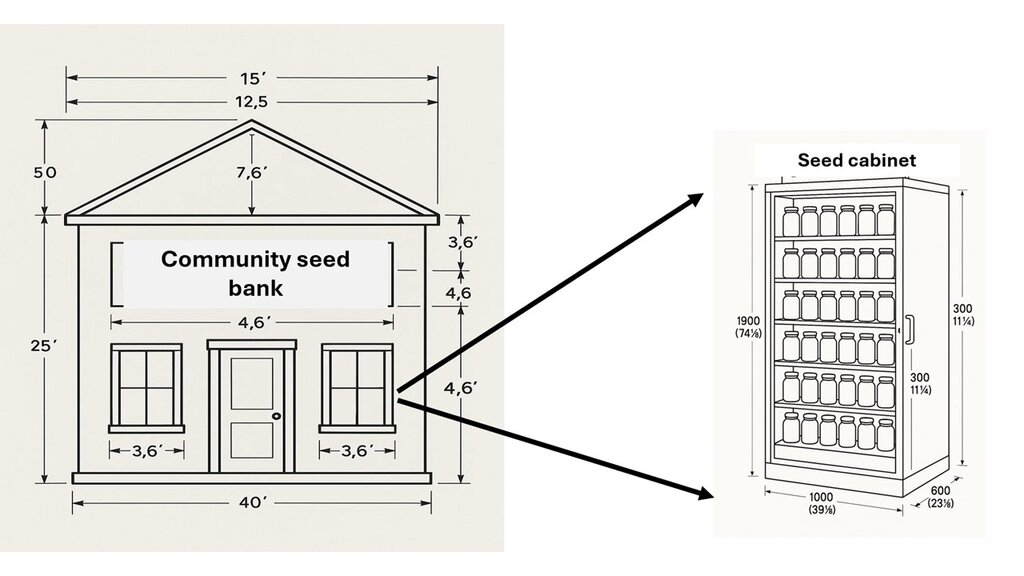Community seed banks [India]
- Creation:
- Update:
- Compiler: Pratik Ramteke
- Editor: –
- Reviewers: Rima Mekdaschi Studer, William Critchley
Seed banks
technologies_7552 - India
View sections
Expand all Collapse all1. General information
1.2 Contact details of resource persons and institutions involved in the assessment and documentation of the Technology
Name of project which facilitated the documentation/ evaluation of the Technology (if relevant)
Enabling Agro-ecological Transitions in Rainfed Landscapes (JIVA)Name of the institution(s) which facilitated the documentation/ evaluation of the Technology (if relevant)
Watershed Organisation Trust (WOTR) - India1.3 Conditions regarding the use of data documented through WOCAT
The compiler and key resource person(s) accept the conditions regarding the use of data documented through WOCAT:
Ja
1.4 Declaration on sustainability of the described Technology
Is the Technology described here problematic with regard to land degradation, so that it cannot be declared a sustainable land management technology?
Nee
2. Description of the SLM Technology
2.1 Short description of the Technology
Definition of the Technology:
A community-based seed bank system is a locally managed initiative where farmers and community members collect, store, and share seeds to ensure germplasm and food security, preserve crop diversity, and support sustainable agriculture. These banks are governed by community rules.
2.2 Detailed description of the Technology
Description:
Community Seed Banks (CSBs) are locally governed systems designed to enhance food and seed security, promote sustainable, climate-resilient farming as well as conserving agrobiodiversity. CSBs bridge traditional agricultural knowledge with evolving best practices, ensuring the continuity of seed diversity adapted to local conditions.
A key function of CSBs is seed preservation and exchange. They provide for the collection of seeds from farmers, prioritizing varieties that have demonstrated superior local adaptation. Seeds are carefully cleaned, dried, and tested for viability before being stored—typically in clay pots in a simple building. The preserved seeds can be used in future planting seasons or distributed during droughts, floods, or pest outbreaks, thereby ensuring timely access to reliable seed material.
A CBS conserves and manages a diverse range of locally important crops including both cereals (sorghum and maize) and legumes (black grams, chickpeas, cowpeas, green grams, green peas, groundnuts, horse grams, red grams, and soybeans). Several traditional and improved cultivars of each crop are stored, selected on their performance under local conditions, including drought tolerance, pest and disease resistance, yield stability, and cultural preference. The quantity of seeds stored per cultivar ranges from 500 grams to 100 kilograms, depending on availability and community demand. For seed protection, both indigenous practices and materials such as wood ash, neem leaves (Azadirachta indica), and chili extract (Capsicum frutescens) are used to prevent pest infestation during storage, minimizing reliance on commercial pesticides.
Management of CSBs is local and participatory. They are generally governed by elected community committees that set the rules for deposit, withdrawal and replenishment. This governance structure ensures that the seed bank reflects the specific needs and knowledge systems of the community. Community engagement is not only vital for operational success but also fosters a sense of ownership and collective responsibility.
CSBs play a multifaceted role. They contribute to agrobiodiversity conservation by safeguarding traditional and wild crop varieties, which are invaluable for future breeding programs. Furthermore, they ensure that farmers can access seeds during critical periods. Additionally, CSBs promote sustainable agricultural practices by reducing reliance on commercial seed systems. They also help to document and share traditional farming knowledge.
The operational structure of a CSB begins with community mobilization and capacity-building focused on seed selection, handling, and storage. Infrastructure requirements are modest. Maintenance involves tasks such as viability testing to ensure the germination potential of stored seeds.
CSBs enhance the resilience of agricultural systems by enabling communities to recover swiftly from crop failures: they also reduce input costs. Furthermore, CSBs empower communities—particularly smallholder farmers and women. Moreover, these banks store vital genetic material for future research.
From a community perspective, the benefits are substantial. However, challenges remain. High initial investments in infrastructure and training are required, and ongoing success depends on strong community engagement and diligent record-keeping. Nevertheless, by preserving the genetic heritage of crops and empowering local communities, CSBs reduce contribute to food sovereignty
2.3 Photos of the Technology
2.5 Country/ region/ locations where the Technology has been applied and which are covered by this assessment
Country:
India
Region/ State/ Province:
Maharashtra
Further specification of location:
Kumbharwadi village, Tal. Sangamner, Dist: Ahilyanagar
Specify the spread of the Technology:
- applied at specific points/ concentrated on a small area
Is/are the technology site(s) located in a permanently protected area?
Nee
Comments:
This documentation covers a single CSB located at Kumbharwadi village.
Map
×2.6 Date of implementation
Indicate year of implementation:
2024
2.7 Introduction of the Technology
Specify how the Technology was introduced:
- through projects/ external interventions
Comments (type of project, etc.):
JIVA – An Agroecology-Based Programme, Implementing Agency: National Bank for Agriculture and Rural Development (NABARD)
3. Classification of the SLM Technology
3.1 Main purpose(s) of the Technology
- improve production
- preserve/ improve biodiversity
- adapt to climate change/ extremes and its impacts
- create beneficial economic impact
- create beneficial social impact
3.2 Current land use type(s) where the Technology is applied
Land use mixed within the same land unit:
Ja
Specify mixed land use (crops/ grazing/ trees):
- Agroforestry

Cropland
- Annual cropping
- Tree and shrub cropping
Annual cropping - Specify crops:
- cereals - maize
- cereals - millet
- fodder crops - alfalfa
- legumes and pulses - soya
- vegetables - root vegetables (carrots, onions, beet, other)
Tree and shrub cropping - Specify crops:
- mango, mangosteen, guava
- Custard Apple
Number of growing seasons per year:
- 2
Is intercropping practiced?
Ja
If yes, specify which crops are intercropped:
Red gram, black gram and green gram intercropped with pearl millet or soybean;
cowpea, horse gram intercropped with groundnuts
Is crop rotation practiced?
Ja
If yes, specify:
Cereals-pulses

Forest/ woodlands
- Tree plantation, afforestation

Waterways, waterbodies, wetlands
- Ponds, dams
Main products/ services:
Irrigation and domestic use
3.3 Has land use changed due to the implementation of the Technology?
Has land use changed due to the implementation of the Technology?
- No (Continue with question 3.4)
3.4 Water supply
Water supply for the land on which the Technology is applied:
- mixed rainfed-irrigated
Comments:
Irrigation source: well, farm pond
3.5 SLM group to which the Technology belongs
- integrated pest and disease management (incl. organic agriculture)
- improved plant varieties/ animal breeds
- ecosystem-based disaster risk reduction
3.6 SLM measures comprising the Technology

structural measures
- S9: Shelters for plants and animals
- S11: Others
Comments:
The CSB includes permanent infrastructure (e.g., a small house or storage facility built with community effort) for the secure preservation and storage of seeds.
3.7 Main types of land degradation addressed by the Technology

chemical soil deterioration
- Cn: fertility decline and reduced organic matter content (not caused by erosion)

biological degradation
- Bh: loss of habitats
- Bs: quality and species composition/ diversity decline
- Bp: increase of pests/ diseases, loss of predators

water degradation
- Hg: change in groundwater/aquifer level

other
Specify:
Agrobiodiversity loss and climate-related seed insecurity
→ The CSB addresses the degradation of crop genetic resources, which is a foundational pillar of sustainable land management.
3.8 Prevention, reduction, or restoration of land degradation
Specify the goal of the Technology with regard to land degradation:
- prevent land degradation
- reduce land degradation
Comments:
→ By conserving traditional seed varieties that require fewer external inputs, the CSB helps prevent soil and biodiversity degradation.
→ Promoting resilient, diverse, and low-input seed systems contributes to reducing ongoing degradation (e.g., fertility decline, loss of biodiversity).
4. Technical specifications, implementation activities, inputs, and costs
4.1 Technical drawing of the Technology
Technical specifications (related to technical drawing):
The structure shown is for reference. Any enclosed room with suitable ventilation and storage conditions can serve as a seed bank.
More detail of storage pots and a brief description:
The seed bank utilizes traditional earthen pots (locally known as matka or bharani) and airtight glass/plastic jars as primary storage containers. The large clay pots are arranged on raised platforms and shelves to avoid moisture contact from the floor. These pots are labelled in local script (Marathi), clearly indicating the crop name (e.g., sorghum, cowpea, maize, etc.) and variety stored. Each pot is covered with cloth and tied securely, ensuring ventilation while preventing pest entry.
These earthen pots are ideal for seed storage in rural, low-cost setups as they:
•Maintain cool internal temperatures, reducing seed deterioration.
•Are naturally aerated, preventing moisture buildup.
•Can be easily sealed using cloth or organic sealants like cow dung or ash to control pests.
The glass and plastic jars used on metal racks are suited for small seed quantities, mainly for short-term storage or display during training sessions and exchanges. Each jar is labelled with variety and harvest details, supporting proper documentation and traceability.
Author:
Pratik Ramteke
Date:
12/05/2025
4.2 General information regarding the calculation of inputs and costs
Specify how costs and inputs were calculated:
- per Technology unit
Specify unit:
1
Specify dimensions of unit (if relevant):
A typical unit consists of a single room structure (approx. 10 x 10 feet) equipped with traditional clay pots (15–25 units) and glass or plastic jars (20–50 units) used for storing seeds. The average storage capacity of one unit is approximately 200–500 kg, depending on the number of crop varieties and seasonal seed availability.
other/ national currency (specify):
Indian Rupees
If relevant, indicate exchange rate from USD to local currency (e.g. 1 USD = 79.9 Brazilian Real): 1 USD =:
84.0
Indicate average wage cost of hired labour per day:
500
4.3 Establishment activities
| Activity | Timing (season) | |
|---|---|---|
| 1. | Site selection for seed bank structure (within SHG household/community building) | February–March (before Rabi harvest) |
| 2. | Construction/preparation of storage structure (room cleaning, plastering, shelf fixing) | March–April |
| 3. | Procurement of local seed varieties | April–May (before monsoon/ Kharif sowing) |
| 4. | Procurement and setup of seed storage containers (clay pots, glass jars, bags) | April–May (before onset of rain) |
| 5. | Installation of racks, shelves, moisture absorbers | May |
| 6. | Labelling of containers and organization of storage system | May–June |
| 7. | Setup of documentation tools (register books, seed stock cards) | June (onset of monsoon) |
4.4 Costs and inputs needed for establishment
| Specify input | Unit | Quantity | Costs per Unit | Total costs per input | % of costs borne by land users | |
|---|---|---|---|---|---|---|
| Labour | Trainer Fees | person days | 1.0 | 2500.0 | 2500.0 | |
| Equipment | Furniture / Rack | pieces | 10.0 | 800.0 | 8000.0 | |
| Equipment | Seed Store Jar and Bag | pieces | 200.0 | 20.0 | 4000.0 | |
| Plant material | Purchase of seed | kg | 50.0 | 450.0 | 22500.0 | |
| Other | Training food charges, materials, boards, exposure visit charges, register book, charts, etc. | 1.0 | 8100.0 | 8100.0 | ||
| Total costs for establishment of the Technology | 45100.0 | |||||
| Total costs for establishment of the Technology in USD | 536.9 | |||||
If land user bore less than 100% of costs, indicate who covered the remaining costs:
Project
Comments:
Around 90-95% of costs were supported by the implementing project JIVA (NABARD), while the remaining was contributed by the community through local materials and voluntary labour
4.5 Maintenance/ recurrent activities
| Activity | Timing/ frequency | |
|---|---|---|
| 1. | Labour (e.g., supervision, helpers) | each cropping season |
| 2. | Replacement of broken jars | as per need |
| 3. | Labelling changes (charts, tags) | annually |
| 4. | Equipment maintenance and repair | as per need |
4.6 Costs and inputs needed for maintenance/ recurrent activities (per year)
| Specify input | Unit | Quantity | Costs per Unit | Total costs per input | % of costs borne by land users | |
|---|---|---|---|---|---|---|
| Labour | Labour (e.g., supervision, helpers) | man-days | 10.0 | 300.0 | 3000.0 | |
| Equipment | Replacement of broken jars | pieces | 10.0 | 20.0 | 200.0 | |
| Equipment | Labelling changes (charts, tags) | 5.0 | 300.0 | 1500.0 | ||
| Equipment | Equipment maintenance and repair | 1.0 | 2000.0 | 2000.0 | ||
| Plant material | 1.0 | |||||
| Total costs for maintenance of the Technology | 6700.0 | |||||
| Total costs for maintenance of the Technology in USD | 79.76 | |||||
If land user bore less than 100% of costs, indicate who covered the remaining costs:
Project (see above under Establishment)
4.7 Most important factors affecting the costs
Describe the most determinate factors affecting the costs:
1. Seed procurement and quality maintenance
2. Storage infrastructure (jars, bags, racks)
3. Training and capacity building for SHGs
4. Labelling and documentation materials
5. Community engagement and operational labour
6. Monitoring and evaluation activities
7. Exposure visits and knowledge sharing
8. Replacement and maintenance of storage materials
5. Natural and human environment
5.1 Climate
Annual rainfall
- < 250 mm
- 251-500 mm
- 501-750 mm
- 751-1,000 mm
- 1,001-1,500 mm
- 1,501-2,000 mm
- 2,001-3,000 mm
- 3,001-4,000 mm
- > 4,000 mm
Specify average annual rainfall (if known), in mm:
450.00
Agro-climatic zone
- semi-arid
5.2 Topography
Slopes on average:
- flat (0-2%)
- gentle (3-5%)
- moderate (6-10%)
- rolling (11-15%)
- hilly (16-30%)
- steep (31-60%)
- very steep (>60%)
Landforms:
- plateau/plains
- ridges
- mountain slopes
- hill slopes
- footslopes
- valley floors
Altitudinal zone:
- 0-100 m a.s.l.
- 101-500 m a.s.l.
- 501-1,000 m a.s.l.
- 1,001-1,500 m a.s.l.
- 1,501-2,000 m a.s.l.
- 2,001-2,500 m a.s.l.
- 2,501-3,000 m a.s.l.
- 3,001-4,000 m a.s.l.
- > 4,000 m a.s.l.
Indicate if the Technology is specifically applied in:
- not relevant
5.3 Soils
Soil depth on average:
- very shallow (0-20 cm)
- shallow (21-50 cm)
- moderately deep (51-80 cm)
- deep (81-120 cm)
- very deep (> 120 cm)
Soil texture (topsoil):
- coarse/ light (sandy)
Soil texture (> 20 cm below surface):
- coarse/ light (sandy)
Topsoil organic matter:
- low (<1%)
If available, attach full soil description or specify the available information, e.g. soil type, soil PH/ acidity, Cation Exchange Capacity, nitrogen, salinity etc.
calcareous
5.4 Water availability and quality
Ground water table:
5-50 m
Availability of surface water:
poor/ none
Water quality (untreated):
poor drinking water (treatment required)
Water quality refers to:
ground water
Is water salinity a problem?
Ja
Is flooding of the area occurring?
Nee
5.5 Biodiversity
Species diversity:
- high
Habitat diversity:
- medium
Comments and further specifications on biodiversity:
The Community Seed Bank maintains and promotes high agrobiodiversity in the surrounding farming areas by preserving a wide range of traditional and locally adapted crop varieties. In total, over 30+ landraces/varieties across 2 cereals and 9 legumes/ pulses (sorghum, maize; green grams, chick peas, horse grams, cowpeas, red grams, green peas, black grams, soybeans and groundnuts) are being actively conserved and circulated in the local community. This contributes significantly to on-farm agrobiodiversity, improves ecosystem resilience, and reduces dependence on uniform commercial seed systems. The continued use and exchange of these seeds by farmers helps sustain crop diversity in the region.
5.6 Characteristics of land users applying the Technology
Sedentary or nomadic:
- Sedentary
Market orientation of production system:
- mixed (subsistence/ commercial)
- commercial/ market
Off-farm income:
- 10-50% of all income
Relative level of wealth:
- average
Individuals or groups:
- individual/ household
Level of mechanization:
- manual work
- mechanized/ motorized
Gender:
- women
- men
Age of land users:
- youth
- middle-aged
- elderly
5.7 Average area of land used by land users applying the Technology
- < 0.5 ha
- 0.5-1 ha
- 1-2 ha
- 2-5 ha
- 5-15 ha
- 15-50 ha
- 50-100 ha
- 100-500 ha
- 500-1,000 ha
- 1,000-10,000 ha
- > 10,000 ha
Is this considered small-, medium- or large-scale (referring to local context)?
- medium-scale
5.8 Land ownership, land use rights, and water use rights
Land ownership:
- communal/ village
- individual, titled
Land use rights:
- communal (organized)
- individual
Water use rights:
- communal (organized)
- individual
Are land use rights based on a traditional legal system?
Ja
Specify:
Land is traditionally managed by village communities or panchayats, with individual families allocated specific plots for cultivation, based on customary rights and community norms.
Comments:
Both formal titles and long-standing traditional practices often govern land and water use. Community seed bank activities are usually hosted on land provided by local institutions or SHGs with shared usage rights.
5.9 Access to services and infrastructure
health:
- poor
- moderate
- good
education:
- poor
- moderate
- good
technical assistance:
- poor
- moderate
- good
employment (e.g. off-farm):
- poor
- moderate
- good
markets:
- poor
- moderate
- good
energy:
- poor
- moderate
- good
roads and transport:
- poor
- moderate
- good
drinking water and sanitation:
- poor
- moderate
- good
financial services:
- poor
- moderate
- good
6. Impacts and concluding statements
6.1 On-site impacts the Technology has shown
Socio-economic impacts
Production
crop production
Comments/ specify:
The Community Seed Bank has contributed to stabilizing crop production rather than significantly increasing it. By providing access to diverse, locally adapted, and resilient seed varieties, the seed bank has helped reduce yield losses during droughts, erratic rainfall, and pest outbreaks, which are common in the region. Farmers report more consistent harvests across seasons, especially in rainfed areas where climate variability poses a major risk.
fodder production
Comments/ specify:
Community seed banks play a crucial role in enhancing fodder production, particularly in smallholder and mixed farming systems. By conserving and providing access to diverse and locally adapted fodder crop varieties, these seed banks help improve the availability and quality of fodder throughout the year. This supports livestock health and productivity, especially during dry seasons or climate-induced fodder shortages. Moreover, farmers can select fodder species that are well-suited to local conditions, which enhances biomass yield and nutritional content. As a result, community seed banks contribute to better livestock management, reduced feed costs, and improved farm income and resilience.
A few traditional fodder crops are also conserved through the seed bank, including:
•Sorghum (dual-purpose varieties used for both grain and fodder)
•Horse gram (used as green fodder in early stages)
•Cowpea and black gram (both provide leafy biomass for fodder)
Propagation method:
These species are primarily stored and distributed as seeds through the seed bank. However, in some cases, vegetative splits of perennial fodder grasses (like Napier or Guinea grass) are maintained in adjacent farmer-managed plots, though this is outside the core seed bank structure and is coordinated informally by SHG members.
fodder quality
Comments/ specify:
Community seed banks enhance fodder quality by providing access to diverse, locally adapted fodder varieties with better nutritional content. This supports healthier livestock and improves milk and meat productivity.
animal production
Comments/ specify:
Community seed banks support animal production by ensuring a steady supply of high-quality fodder, which improves livestock nutrition and health. This leads to increased milk yield, better weight gain, and overall improved animal productivity.
risk of production failure
Comments/ specify:
Community seed banks reduce the risk of production failure by offering diverse, locally adapted seed varieties that are more resilient to pests, diseases, and climate stress. This genetic diversity helps stabilize yields and ensures better crop survival under adverse conditions.
land management
Comments/ specify:
Community seed banks promote better land management by encouraging the use of traditional and climate-resilient crop varieties that are well-suited to local soils and conditions. This supports sustainable farming practices, reduces the need for chemical inputs, and helps maintain soil health and fertility.
Water availability and quality
irrigation water availability
Comments/ specify:
Community seed banks contribute to improved irrigation water availability by promoting drought-tolerant and water-efficient crop varieties. These varieties require less water, helping farmers conserve irrigation resources and maintain productivity during water-scarce periods.
Income and costs
expenses on agricultural inputs
Comments/ specify:
Community seed banks help reduce expenses on agricultural inputs by providing farmers with free or low-cost seeds, minimizing the need to purchase commercial seeds. They also promote the use of traditional, low-input crop varieties, which often require fewer fertilizers and pesticides.
Ecological impacts
Water cycle/ runoff
water quality
Comments/ specify:
Reduced agrochemical use linked with traditional varieties.
harvesting/ collection of water
Comments/ specify:
Seed bank farmers often adopt moisture conservation practices.
surface runoff
Comments/ specify:
Improved ground cover from diversified cropping.
excess water drainage
groundwater table/ aquifer
Comments/ specify:
Due to adoption of traditional drought-tolerant and short-duration crops.
evaporation
Comments/ specify:
Better mulching and cover practices.
Soil
soil moisture
Comments/ specify:
Traditional crops conserve more soil moisture.
soil cover
Comments/ specify:
Due to mixed/intercropping encouraged with native seeds.
soil loss
Comments/ specify:
Improved ground cover
nutrient cycling/ recharge
Biodiversity: vegetation, animals
Vegetation cover
Comments/ specify:
More resilient and diverse crop cover.
biomass/ above ground C
Comments/ specify:
Enhanced crop residues and fodder availability
plant diversity
Comments/ specify:
Local seeds increase genetic diversity.
invasive alien species
Comments/ specify:
Minimal effect; some replacement of hybrids.
animal diversity
Comments/ specify:
Indigenous cropping supports native fauna.
beneficial species
Comments/ specify:
Pollinators and natural predators increased.
habitat diversity
Comments/ specify:
Seed banks revive landrace-driven agro-ecosystems.
pest/ disease control
Comments/ specify:
Traditional varieties are often resistant.
Climate and disaster risk reduction
flood impacts
Comments/ specify:
More stable cropping systems.
drought impacts
Comments/ specify:
Drought-tolerant crops used.
emission of carbon and greenhouse gases
Comments/ specify:
Reduced fertilizer use.
wind velocity
Comments/ specify:
Increased cover reduces erosion
micro-climate
Comments/ specify:
More vegetative cover and soil moisture.
Specify assessment of on-site impacts (measurements):
Estimates based on a mixture of science-based observations and expectations, and community-based local knowledge
6.2 Off-site impacts the Technology has shown
water availability
Comments/ specify:
Due to improved recharge and less runoff.
downstream flooding
Comments/ specify:
Less runoff due to cover.
downstream siltation
Comments/ specify:
Soil conservation from better cover.
groundwater/ river pollution
Comments/ specify:
Reduced chemical input.
damage on neighbours' fields
Comments/ specify:
Less runoff.
impact of greenhouse gases
Comments/ specify:
Reduced fertilizer usage and better biomass.
Specify assessment of off-site impacts (measurements):
Based on field observations, local knowledge, and documentation by SHG members.
Proxy indicators: changes in vegetation cover, crop diversity, seasonal water availability, soil health traits.
6.3 Exposure and sensitivity of the Technology to gradual climate change and climate-related extremes/ disasters (as perceived by land users)
Gradual climate change
Gradual climate change
| Season | increase or decrease | How does the Technology cope with it? | |
|---|---|---|---|
| annual temperature | increase | very well | |
| annual rainfall | decrease | very well | |
| seasonal rainfall | wet/ rainy season | decrease | very well |
Climate-related extremes (disasters)
Meteorological disasters
| How does the Technology cope with it? | |
|---|---|
| local hailstorm | well |
| local windstorm | well |
Hydrological disasters
| How does the Technology cope with it? | |
|---|---|
| flash flood | moderately |
| landslide | moderately |
Comments:
Community Seed Banks act as a resilient strategy by:
Ensuring timely seed availability during disasters.
Preserving genetic diversity to cope with stress.
Enhancing local adaptive capacity.
6.4 Cost-benefit analysis
How do the benefits compare with the establishment costs (from land users’ perspective)?
Short-term returns:
slightly negative
Long-term returns:
positive
How do the benefits compare with the maintenance/ recurrent costs (from land users' perspective)?
Short-term returns:
neutral/ balanced
Long-term returns:
positive
6.5 Adoption of the Technology
- single cases/ experimental
Comments:
This submission is based on a single Community Seed Bank (CSB) unit located in Kumbharwadi village, which is the only seed bank supported under the project. While other CSBs may exist in Ahilyanagar block, they fall outside the scope of this analysis. The success of this model is inspiring interest in informal replication in nearby areas.
6.6 Adaptation
Has the Technology been modified recently to adapt to changing conditions?
Nee
6.7 Strengths/ advantages/ opportunities of the Technology
| Strengths/ advantages/ opportunities in the land user’s view |
|---|
| Access to quality seeds at lower or no cost |
| Empowers women and SHG members through training and leadership |
| Encourages community cooperation and local innovation |
| Reduces dependency on markets or middlemen |
| Preserves traditional, climate-resilient varieties |
| Strengths/ advantages/ opportunities in the compiler’s or other key resource person’s view |
|---|
| Supports in-situ conservation of agrobiodiversity |
| Enhances community resilience to climate change |
| Promotes low-cost, sustainable, and decentralized seed systems |
| Offers a replicable and scalable model for other villages |
| Encourages gender equity and grassroots participation |
6.8 Weaknesses/ disadvantages/ risks of the Technology and ways of overcoming them
| Weaknesses/ disadvantages/ risks in the land user’s view | How can they be overcome? |
|---|---|
| Lack of technical knowledge on seed preservation and storage | Provide regular training and capacity-building sessions |
| Risk of seed damage due to pests, moisture, or improper storage | Ensure proper infrastructure (airtight jars, dry room, pest-proofing) |
| Limited availability of diverse or improved seed varieties | Collaborate with agricultural universities, KVKs, and other seed networks |
| Difficulty in maintaining records and documentation | Assign trained SHG members; provide formats and digital tools if possible |
| Lack of continuous funding for maintenance and expansion | Link with government schemes, CSR funding, or community contribution models |
| Conflicts or poor participation among SHG members | Set clear guidelines and participatory rules; involve local leaders for mediation |
| Fear of crop failure from local varieties in some cases | Promote participatory varietal trials and mix traditional with improved seeds |
| Weaknesses/ disadvantages/ risks in the compiler’s or other key resource person’s view | How can they be overcome? |
|---|---|
| Limited institutional capacity for long-term sustainability | Integrate seed bank into local institutions (e.g., SHG federations, Panchayats); build leadership |
| Poor documentation and data management | Use standardized formats, digital tools, and provide training on record-keeping |
| Risk of genetic erosion due to poor selection or replacement of varieties | Develop clear varietal selection criteria; involve technical experts in curation |
| Low initial adoption by other community members | Conduct awareness campaigns, field demonstrations, and seed fairs |
| Dependency on external facilitators in early stages | Focus on capacity building, handover plans, and mentoring local champions |
| Inadequate monitoring and evaluation frameworks | Establish regular review mechanisms with community feedback and external support |
| Climate risks (e.g., drought, unseasonal rains) affecting seed regeneration | Promote drought/heat-tolerant varieties; staggered planting; maintain seed stock buffer |
7. References and links
7.1 Methods/ sources of information
- field visits, field surveys
15
- interviews with land users
2
- compilation from reports and other existing documentation
When were the data compiled (in the field)?
01/05/2025
7.3 Links to relevant online information
Title/ description:
Weblink
URL:
https://www.fao.org/fileadmin/user_upload/fao_ilo/pdf/Other_docs/FAO/Community_Seed_Banks.pdf
Title/ description:
Weblink
URL:
http://pgrinformatics.nbpgr.ernet.in/onfc/onfcCSB.aspx
Title/ description:
Weblink
URL:
https://alliancebioversityciat.org/stories/community-seed-banks-empower-farmers-address-climate-risk-india
Title/ description:
Weblink
URL:
https://openknowledge.fao.org/items/797ba1b6-9640-43c7-a3ee-9cab7119dfa8
Links and modules
Expand all Collapse allLinks
No links
Modules
No modules







